Research Proposal: SHRM Impact on US Organisational Performance
VerifiedAdded on 2022/08/18
|14
|2486
|16
Project
AI Summary
This research proposal investigates the impact of Strategic Human Resource Management (SHRM) on organisational performance within US companies. The study aims to understand how SHRM influences organizational success by examining various SHRM practices and their effects on performance, using a positivism approach and survey data. The proposal includes an introduction outlining the problem statement, research aims, questions, and justification, followed by a literature review that defines SHRM and organizational performance. The methodology section details the research philosophy, design, data collection methods (surveys and interviews), and ethical guidelines. The proposal also includes a time frame and concludes with the expected positive correlation between SHRM and organizational performance, emphasizing the importance of aligning human resource strategies with organizational goals. The study is expected to provide insights into enhancing performance and gaining competitive advantages.
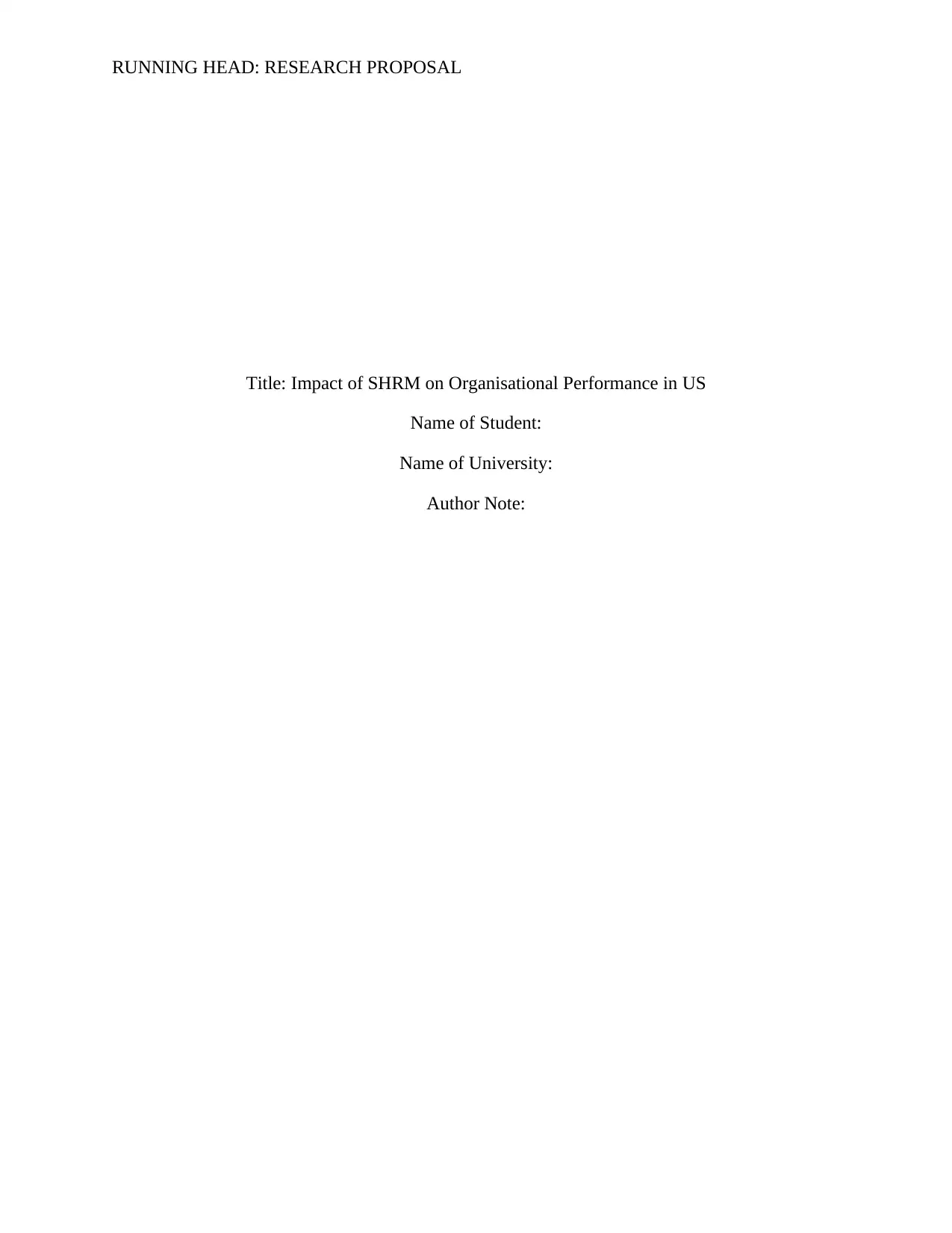
RUNNING HEAD: RESEARCH PROPOSAL
Title: Impact of SHRM on Organisational Performance in US
Name of Student:
Name of University:
Author Note:
Title: Impact of SHRM on Organisational Performance in US
Name of Student:
Name of University:
Author Note:
Paraphrase This Document
Need a fresh take? Get an instant paraphrase of this document with our AI Paraphraser
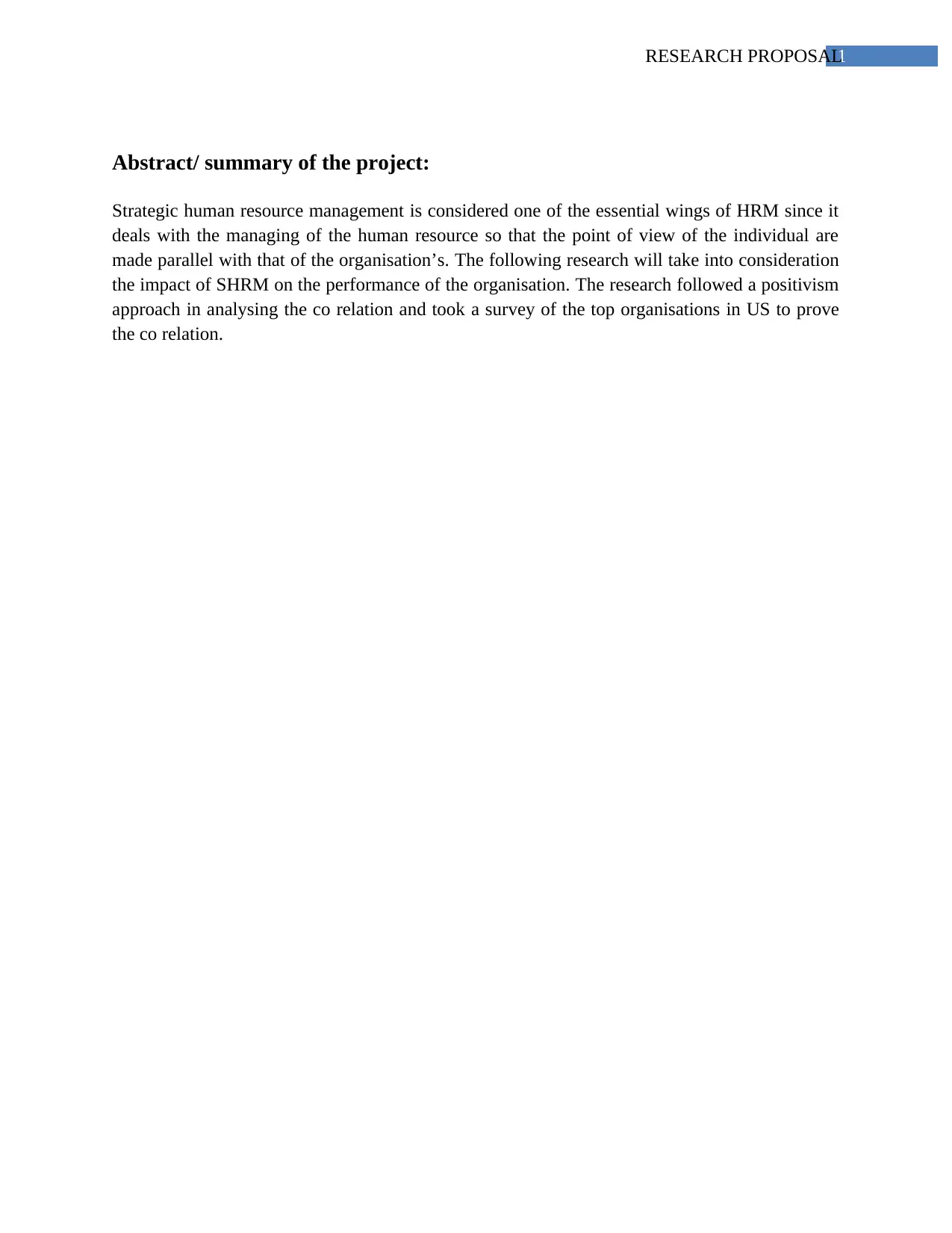
1RESEARCH PROPOSAL
Abstract/ summary of the project:
Strategic human resource management is considered one of the essential wings of HRM since it
deals with the managing of the human resource so that the point of view of the individual are
made parallel with that of the organisation’s. The following research will take into consideration
the impact of SHRM on the performance of the organisation. The research followed a positivism
approach in analysing the co relation and took a survey of the top organisations in US to prove
the co relation.
Abstract/ summary of the project:
Strategic human resource management is considered one of the essential wings of HRM since it
deals with the managing of the human resource so that the point of view of the individual are
made parallel with that of the organisation’s. The following research will take into consideration
the impact of SHRM on the performance of the organisation. The research followed a positivism
approach in analysing the co relation and took a survey of the top organisations in US to prove
the co relation.
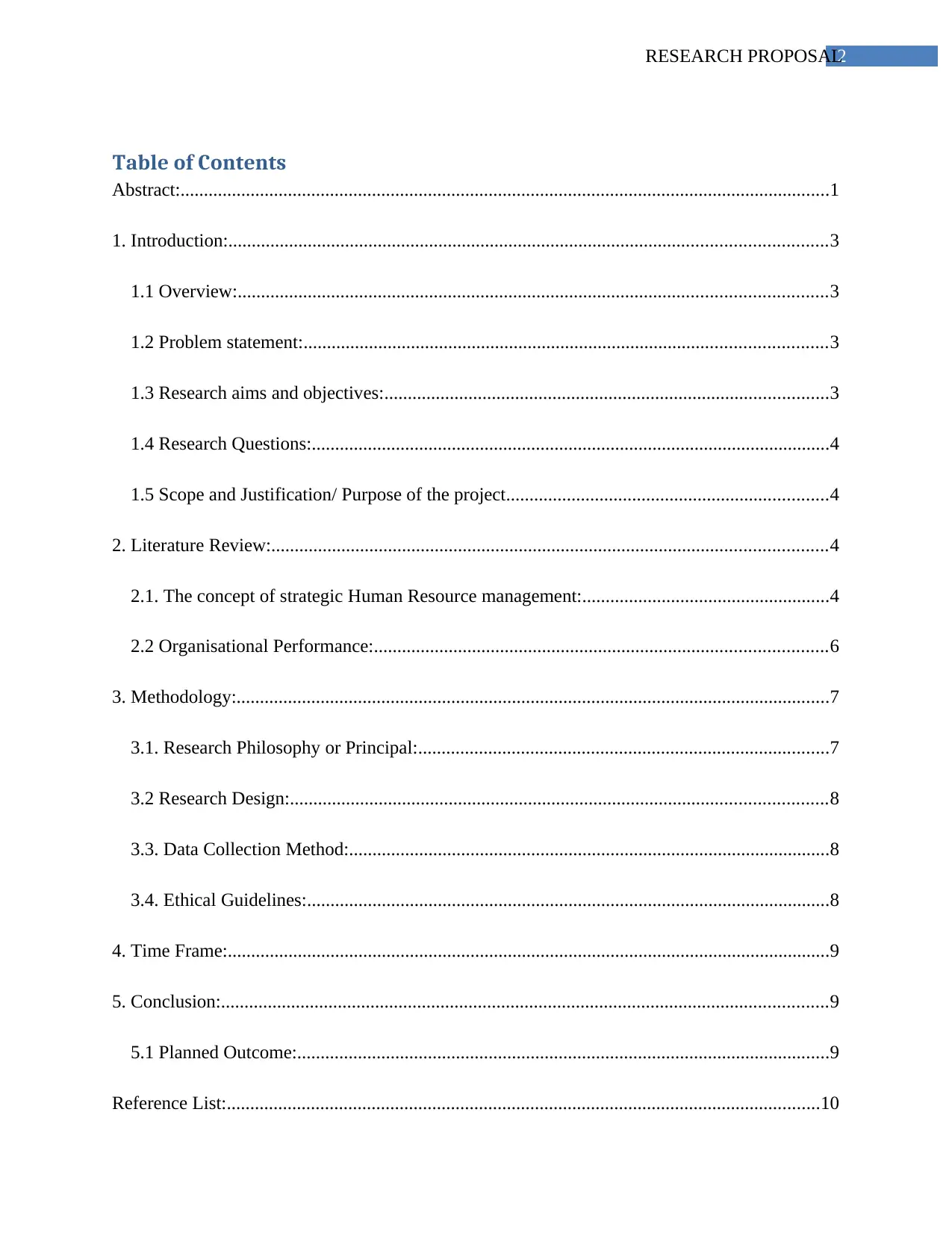
2RESEARCH PROPOSAL
Table of Contents
Abstract:...........................................................................................................................................1
1. Introduction:................................................................................................................................3
1.1 Overview:..............................................................................................................................3
1.2 Problem statement:................................................................................................................3
1.3 Research aims and objectives:...............................................................................................3
1.4 Research Questions:...............................................................................................................4
1.5 Scope and Justification/ Purpose of the project.....................................................................4
2. Literature Review:.......................................................................................................................4
2.1. The concept of strategic Human Resource management:.....................................................4
2.2 Organisational Performance:.................................................................................................6
3. Methodology:...............................................................................................................................7
3.1. Research Philosophy or Principal:........................................................................................7
3.2 Research Design:...................................................................................................................8
3.3. Data Collection Method:.......................................................................................................8
3.4. Ethical Guidelines:................................................................................................................8
4. Time Frame:.................................................................................................................................9
5. Conclusion:..................................................................................................................................9
5.1 Planned Outcome:..................................................................................................................9
Reference List:...............................................................................................................................10
Table of Contents
Abstract:...........................................................................................................................................1
1. Introduction:................................................................................................................................3
1.1 Overview:..............................................................................................................................3
1.2 Problem statement:................................................................................................................3
1.3 Research aims and objectives:...............................................................................................3
1.4 Research Questions:...............................................................................................................4
1.5 Scope and Justification/ Purpose of the project.....................................................................4
2. Literature Review:.......................................................................................................................4
2.1. The concept of strategic Human Resource management:.....................................................4
2.2 Organisational Performance:.................................................................................................6
3. Methodology:...............................................................................................................................7
3.1. Research Philosophy or Principal:........................................................................................7
3.2 Research Design:...................................................................................................................8
3.3. Data Collection Method:.......................................................................................................8
3.4. Ethical Guidelines:................................................................................................................8
4. Time Frame:.................................................................................................................................9
5. Conclusion:..................................................................................................................................9
5.1 Planned Outcome:..................................................................................................................9
Reference List:...............................................................................................................................10
⊘ This is a preview!⊘
Do you want full access?
Subscribe today to unlock all pages.

Trusted by 1+ million students worldwide
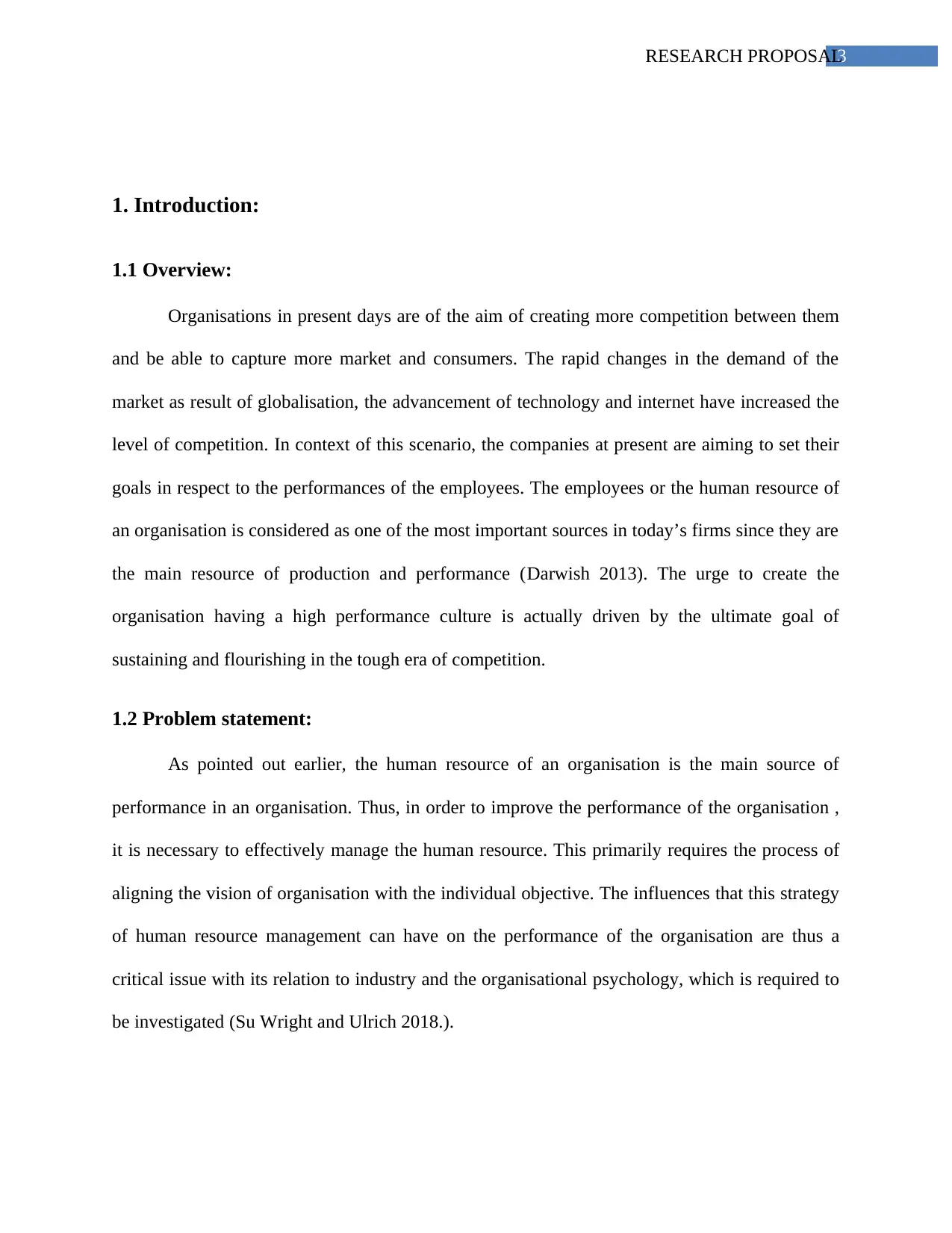
3RESEARCH PROPOSAL
1. Introduction:
1.1 Overview:
Organisations in present days are of the aim of creating more competition between them
and be able to capture more market and consumers. The rapid changes in the demand of the
market as result of globalisation, the advancement of technology and internet have increased the
level of competition. In context of this scenario, the companies at present are aiming to set their
goals in respect to the performances of the employees. The employees or the human resource of
an organisation is considered as one of the most important sources in today’s firms since they are
the main resource of production and performance (Darwish 2013). The urge to create the
organisation having a high performance culture is actually driven by the ultimate goal of
sustaining and flourishing in the tough era of competition.
1.2 Problem statement:
As pointed out earlier, the human resource of an organisation is the main source of
performance in an organisation. Thus, in order to improve the performance of the organisation ,
it is necessary to effectively manage the human resource. This primarily requires the process of
aligning the vision of organisation with the individual objective. The influences that this strategy
of human resource management can have on the performance of the organisation are thus a
critical issue with its relation to industry and the organisational psychology, which is required to
be investigated (Su Wright and Ulrich 2018.).
1. Introduction:
1.1 Overview:
Organisations in present days are of the aim of creating more competition between them
and be able to capture more market and consumers. The rapid changes in the demand of the
market as result of globalisation, the advancement of technology and internet have increased the
level of competition. In context of this scenario, the companies at present are aiming to set their
goals in respect to the performances of the employees. The employees or the human resource of
an organisation is considered as one of the most important sources in today’s firms since they are
the main resource of production and performance (Darwish 2013). The urge to create the
organisation having a high performance culture is actually driven by the ultimate goal of
sustaining and flourishing in the tough era of competition.
1.2 Problem statement:
As pointed out earlier, the human resource of an organisation is the main source of
performance in an organisation. Thus, in order to improve the performance of the organisation ,
it is necessary to effectively manage the human resource. This primarily requires the process of
aligning the vision of organisation with the individual objective. The influences that this strategy
of human resource management can have on the performance of the organisation are thus a
critical issue with its relation to industry and the organisational psychology, which is required to
be investigated (Su Wright and Ulrich 2018.).
Paraphrase This Document
Need a fresh take? Get an instant paraphrase of this document with our AI Paraphraser
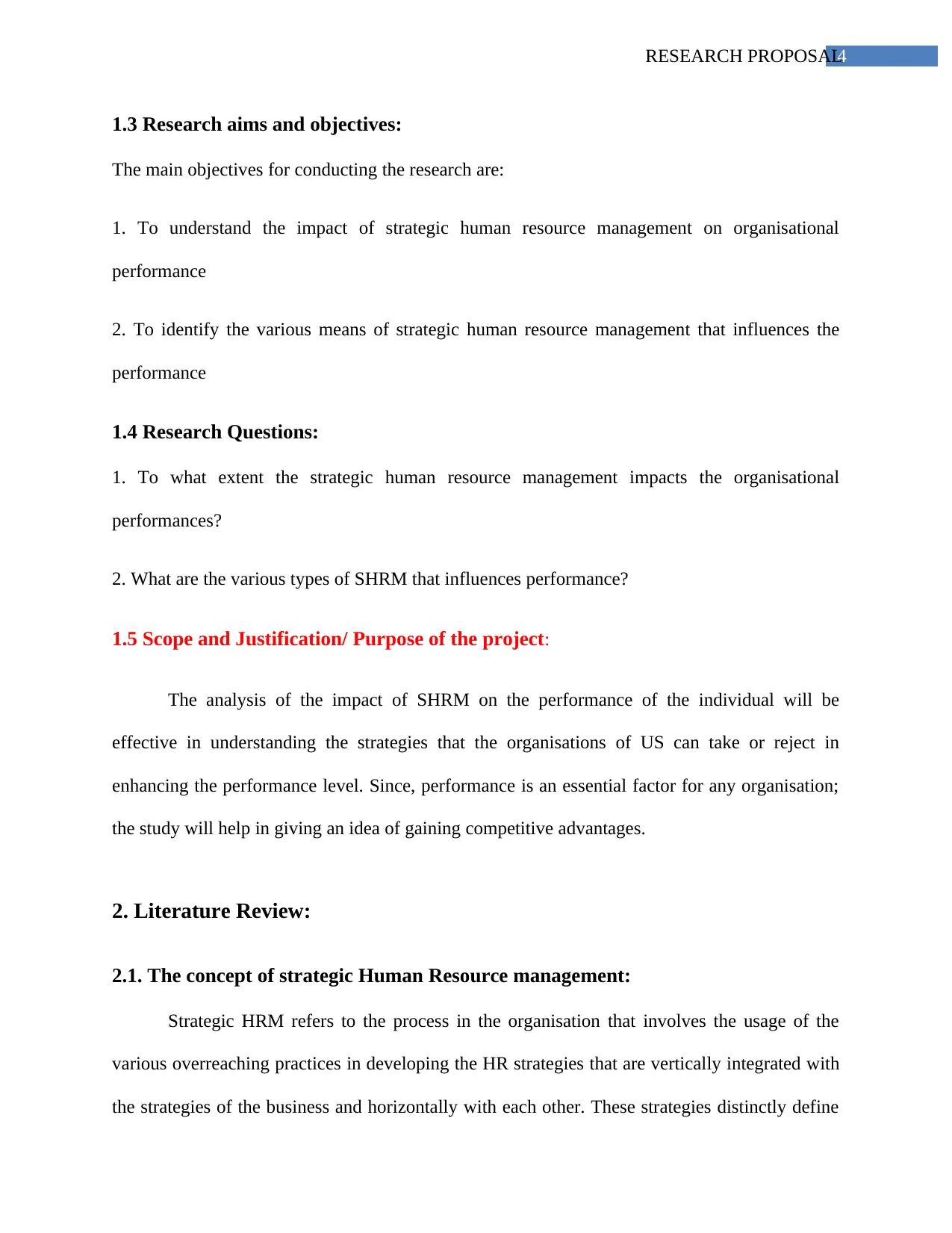
4RESEARCH PROPOSAL
1.3 Research aims and objectives:
The main objectives for conducting the research are:
1. To understand the impact of strategic human resource management on organisational
performance
2. To identify the various means of strategic human resource management that influences the
performance
1.4 Research Questions:
1. To what extent the strategic human resource management impacts the organisational
performances?
2. What are the various types of SHRM that influences performance?
1.5 Scope and Justification/ Purpose of the project:
The analysis of the impact of SHRM on the performance of the individual will be
effective in understanding the strategies that the organisations of US can take or reject in
enhancing the performance level. Since, performance is an essential factor for any organisation;
the study will help in giving an idea of gaining competitive advantages.
2. Literature Review:
2.1. The concept of strategic Human Resource management:
Strategic HRM refers to the process in the organisation that involves the usage of the
various overreaching practices in developing the HR strategies that are vertically integrated with
the strategies of the business and horizontally with each other. These strategies distinctly define
1.3 Research aims and objectives:
The main objectives for conducting the research are:
1. To understand the impact of strategic human resource management on organisational
performance
2. To identify the various means of strategic human resource management that influences the
performance
1.4 Research Questions:
1. To what extent the strategic human resource management impacts the organisational
performances?
2. What are the various types of SHRM that influences performance?
1.5 Scope and Justification/ Purpose of the project:
The analysis of the impact of SHRM on the performance of the individual will be
effective in understanding the strategies that the organisations of US can take or reject in
enhancing the performance level. Since, performance is an essential factor for any organisation;
the study will help in giving an idea of gaining competitive advantages.
2. Literature Review:
2.1. The concept of strategic Human Resource management:
Strategic HRM refers to the process in the organisation that involves the usage of the
various overreaching practices in developing the HR strategies that are vertically integrated with
the strategies of the business and horizontally with each other. These strategies distinctly define
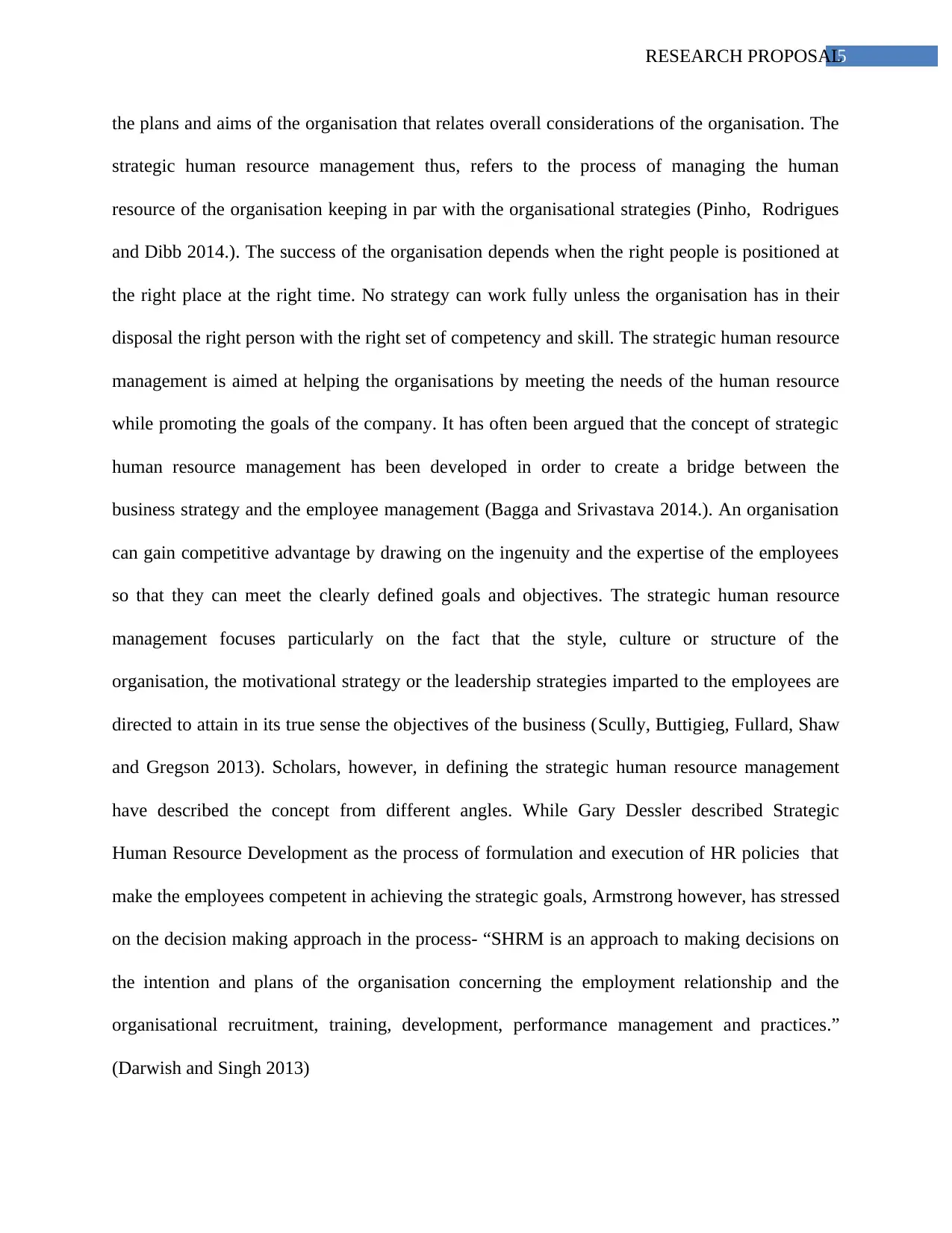
5RESEARCH PROPOSAL
the plans and aims of the organisation that relates overall considerations of the organisation. The
strategic human resource management thus, refers to the process of managing the human
resource of the organisation keeping in par with the organisational strategies (Pinho, Rodrigues
and Dibb 2014.). The success of the organisation depends when the right people is positioned at
the right place at the right time. No strategy can work fully unless the organisation has in their
disposal the right person with the right set of competency and skill. The strategic human resource
management is aimed at helping the organisations by meeting the needs of the human resource
while promoting the goals of the company. It has often been argued that the concept of strategic
human resource management has been developed in order to create a bridge between the
business strategy and the employee management (Bagga and Srivastava 2014.). An organisation
can gain competitive advantage by drawing on the ingenuity and the expertise of the employees
so that they can meet the clearly defined goals and objectives. The strategic human resource
management focuses particularly on the fact that the style, culture or structure of the
organisation, the motivational strategy or the leadership strategies imparted to the employees are
directed to attain in its true sense the objectives of the business (Scully, Buttigieg, Fullard, Shaw
and Gregson 2013). Scholars, however, in defining the strategic human resource management
have described the concept from different angles. While Gary Dessler described Strategic
Human Resource Development as the process of formulation and execution of HR policies that
make the employees competent in achieving the strategic goals, Armstrong however, has stressed
on the decision making approach in the process- “SHRM is an approach to making decisions on
the intention and plans of the organisation concerning the employment relationship and the
organisational recruitment, training, development, performance management and practices.”
(Darwish and Singh 2013)
the plans and aims of the organisation that relates overall considerations of the organisation. The
strategic human resource management thus, refers to the process of managing the human
resource of the organisation keeping in par with the organisational strategies (Pinho, Rodrigues
and Dibb 2014.). The success of the organisation depends when the right people is positioned at
the right place at the right time. No strategy can work fully unless the organisation has in their
disposal the right person with the right set of competency and skill. The strategic human resource
management is aimed at helping the organisations by meeting the needs of the human resource
while promoting the goals of the company. It has often been argued that the concept of strategic
human resource management has been developed in order to create a bridge between the
business strategy and the employee management (Bagga and Srivastava 2014.). An organisation
can gain competitive advantage by drawing on the ingenuity and the expertise of the employees
so that they can meet the clearly defined goals and objectives. The strategic human resource
management focuses particularly on the fact that the style, culture or structure of the
organisation, the motivational strategy or the leadership strategies imparted to the employees are
directed to attain in its true sense the objectives of the business (Scully, Buttigieg, Fullard, Shaw
and Gregson 2013). Scholars, however, in defining the strategic human resource management
have described the concept from different angles. While Gary Dessler described Strategic
Human Resource Development as the process of formulation and execution of HR policies that
make the employees competent in achieving the strategic goals, Armstrong however, has stressed
on the decision making approach in the process- “SHRM is an approach to making decisions on
the intention and plans of the organisation concerning the employment relationship and the
organisational recruitment, training, development, performance management and practices.”
(Darwish and Singh 2013)
⊘ This is a preview!⊘
Do you want full access?
Subscribe today to unlock all pages.

Trusted by 1+ million students worldwide
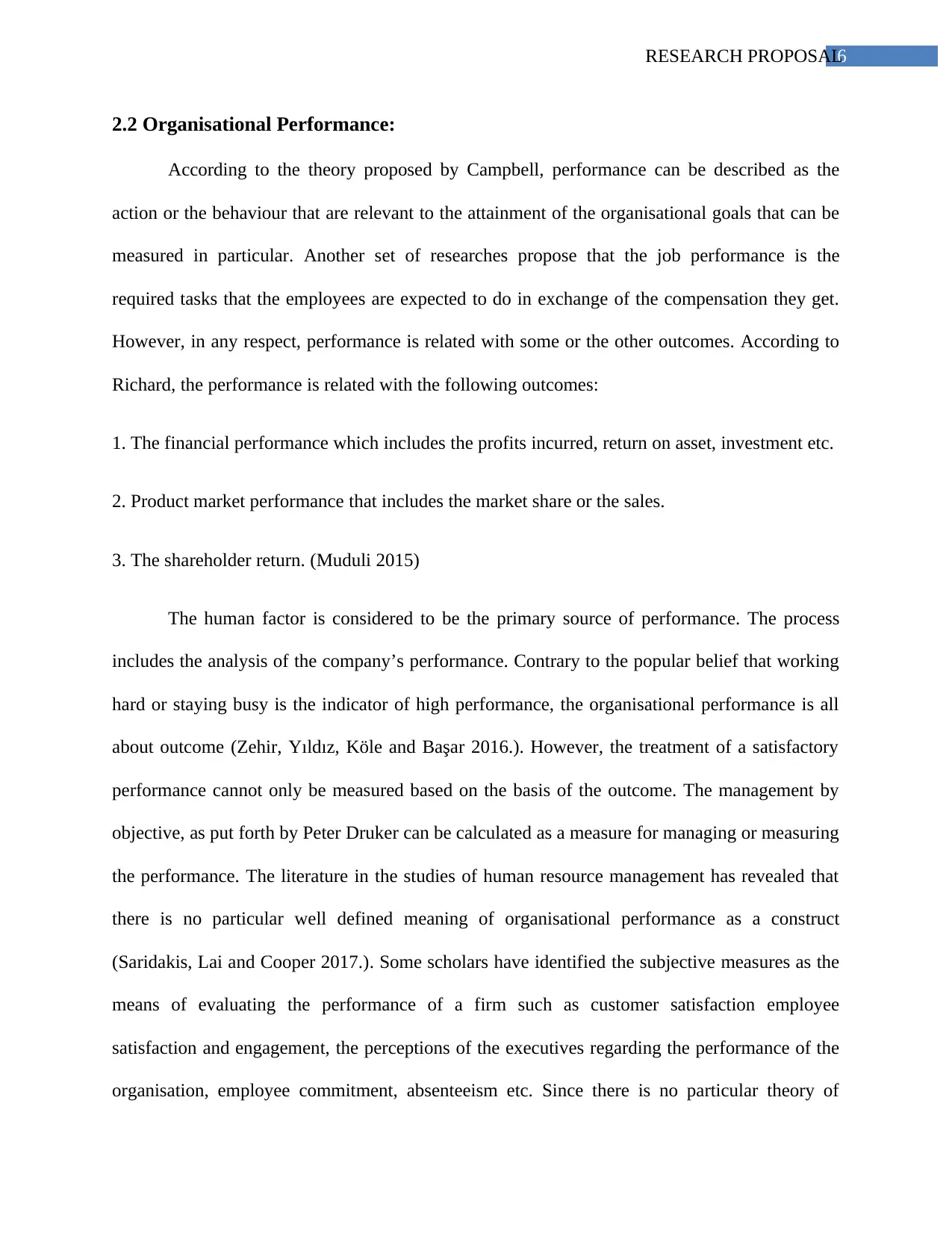
6RESEARCH PROPOSAL
2.2 Organisational Performance:
According to the theory proposed by Campbell, performance can be described as the
action or the behaviour that are relevant to the attainment of the organisational goals that can be
measured in particular. Another set of researches propose that the job performance is the
required tasks that the employees are expected to do in exchange of the compensation they get.
However, in any respect, performance is related with some or the other outcomes. According to
Richard, the performance is related with the following outcomes:
1. The financial performance which includes the profits incurred, return on asset, investment etc.
2. Product market performance that includes the market share or the sales.
3. The shareholder return. (Muduli 2015)
The human factor is considered to be the primary source of performance. The process
includes the analysis of the company’s performance. Contrary to the popular belief that working
hard or staying busy is the indicator of high performance, the organisational performance is all
about outcome (Zehir, Yıldız, Köle and Başar 2016.). However, the treatment of a satisfactory
performance cannot only be measured based on the basis of the outcome. The management by
objective, as put forth by Peter Druker can be calculated as a measure for managing or measuring
the performance. The literature in the studies of human resource management has revealed that
there is no particular well defined meaning of organisational performance as a construct
(Saridakis, Lai and Cooper 2017.). Some scholars have identified the subjective measures as the
means of evaluating the performance of a firm such as customer satisfaction employee
satisfaction and engagement, the perceptions of the executives regarding the performance of the
organisation, employee commitment, absenteeism etc. Since there is no particular theory of
2.2 Organisational Performance:
According to the theory proposed by Campbell, performance can be described as the
action or the behaviour that are relevant to the attainment of the organisational goals that can be
measured in particular. Another set of researches propose that the job performance is the
required tasks that the employees are expected to do in exchange of the compensation they get.
However, in any respect, performance is related with some or the other outcomes. According to
Richard, the performance is related with the following outcomes:
1. The financial performance which includes the profits incurred, return on asset, investment etc.
2. Product market performance that includes the market share or the sales.
3. The shareholder return. (Muduli 2015)
The human factor is considered to be the primary source of performance. The process
includes the analysis of the company’s performance. Contrary to the popular belief that working
hard or staying busy is the indicator of high performance, the organisational performance is all
about outcome (Zehir, Yıldız, Köle and Başar 2016.). However, the treatment of a satisfactory
performance cannot only be measured based on the basis of the outcome. The management by
objective, as put forth by Peter Druker can be calculated as a measure for managing or measuring
the performance. The literature in the studies of human resource management has revealed that
there is no particular well defined meaning of organisational performance as a construct
(Saridakis, Lai and Cooper 2017.). Some scholars have identified the subjective measures as the
means of evaluating the performance of a firm such as customer satisfaction employee
satisfaction and engagement, the perceptions of the executives regarding the performance of the
organisation, employee commitment, absenteeism etc. Since there is no particular theory of
Paraphrase This Document
Need a fresh take? Get an instant paraphrase of this document with our AI Paraphraser
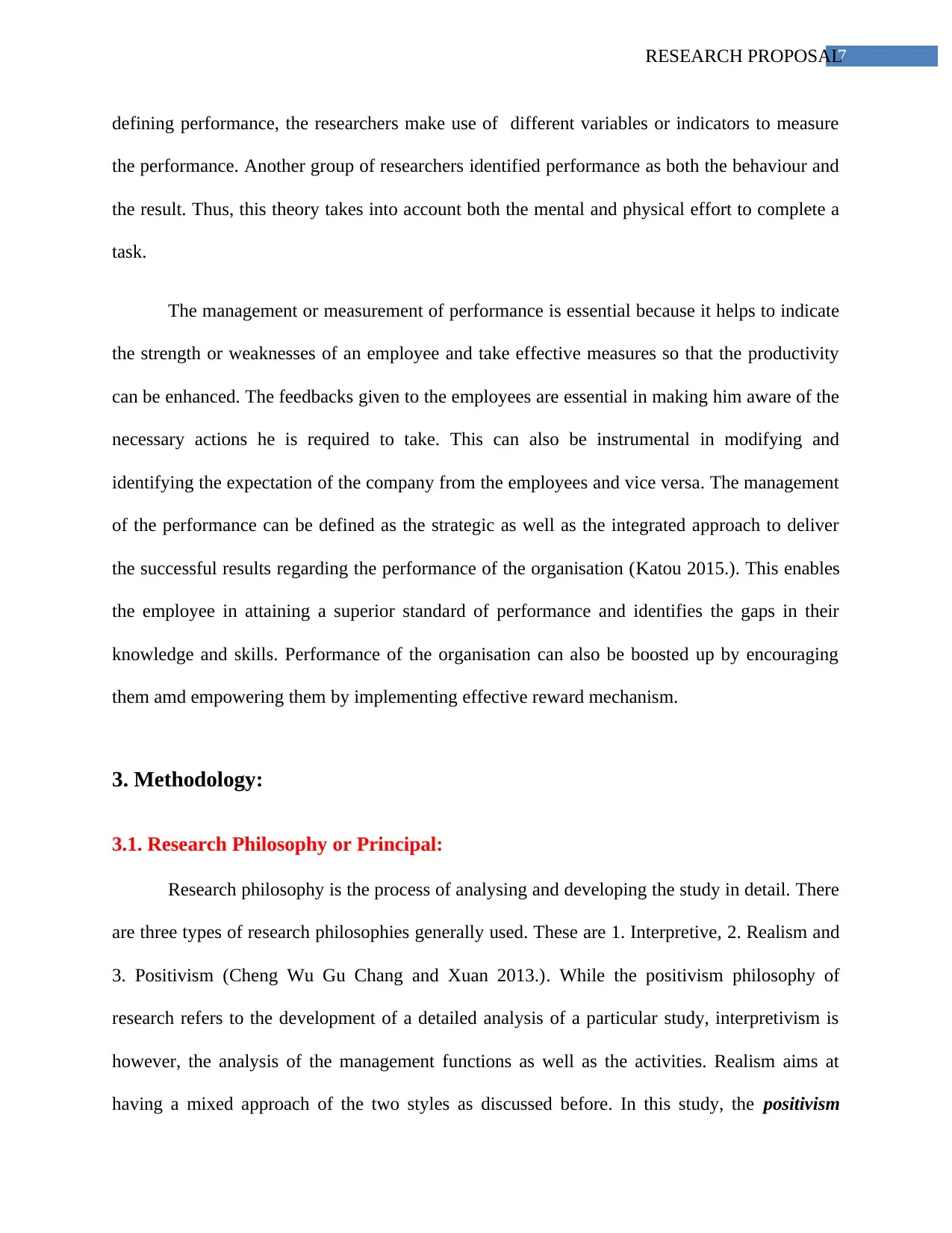
7RESEARCH PROPOSAL
defining performance, the researchers make use of different variables or indicators to measure
the performance. Another group of researchers identified performance as both the behaviour and
the result. Thus, this theory takes into account both the mental and physical effort to complete a
task.
The management or measurement of performance is essential because it helps to indicate
the strength or weaknesses of an employee and take effective measures so that the productivity
can be enhanced. The feedbacks given to the employees are essential in making him aware of the
necessary actions he is required to take. This can also be instrumental in modifying and
identifying the expectation of the company from the employees and vice versa. The management
of the performance can be defined as the strategic as well as the integrated approach to deliver
the successful results regarding the performance of the organisation (Katou 2015.). This enables
the employee in attaining a superior standard of performance and identifies the gaps in their
knowledge and skills. Performance of the organisation can also be boosted up by encouraging
them amd empowering them by implementing effective reward mechanism.
3. Methodology:
3.1. Research Philosophy or Principal:
Research philosophy is the process of analysing and developing the study in detail. There
are three types of research philosophies generally used. These are 1. Interpretive, 2. Realism and
3. Positivism (Cheng Wu Gu Chang and Xuan 2013.). While the positivism philosophy of
research refers to the development of a detailed analysis of a particular study, interpretivism is
however, the analysis of the management functions as well as the activities. Realism aims at
having a mixed approach of the two styles as discussed before. In this study, the positivism
defining performance, the researchers make use of different variables or indicators to measure
the performance. Another group of researchers identified performance as both the behaviour and
the result. Thus, this theory takes into account both the mental and physical effort to complete a
task.
The management or measurement of performance is essential because it helps to indicate
the strength or weaknesses of an employee and take effective measures so that the productivity
can be enhanced. The feedbacks given to the employees are essential in making him aware of the
necessary actions he is required to take. This can also be instrumental in modifying and
identifying the expectation of the company from the employees and vice versa. The management
of the performance can be defined as the strategic as well as the integrated approach to deliver
the successful results regarding the performance of the organisation (Katou 2015.). This enables
the employee in attaining a superior standard of performance and identifies the gaps in their
knowledge and skills. Performance of the organisation can also be boosted up by encouraging
them amd empowering them by implementing effective reward mechanism.
3. Methodology:
3.1. Research Philosophy or Principal:
Research philosophy is the process of analysing and developing the study in detail. There
are three types of research philosophies generally used. These are 1. Interpretive, 2. Realism and
3. Positivism (Cheng Wu Gu Chang and Xuan 2013.). While the positivism philosophy of
research refers to the development of a detailed analysis of a particular study, interpretivism is
however, the analysis of the management functions as well as the activities. Realism aims at
having a mixed approach of the two styles as discussed before. In this study, the positivism
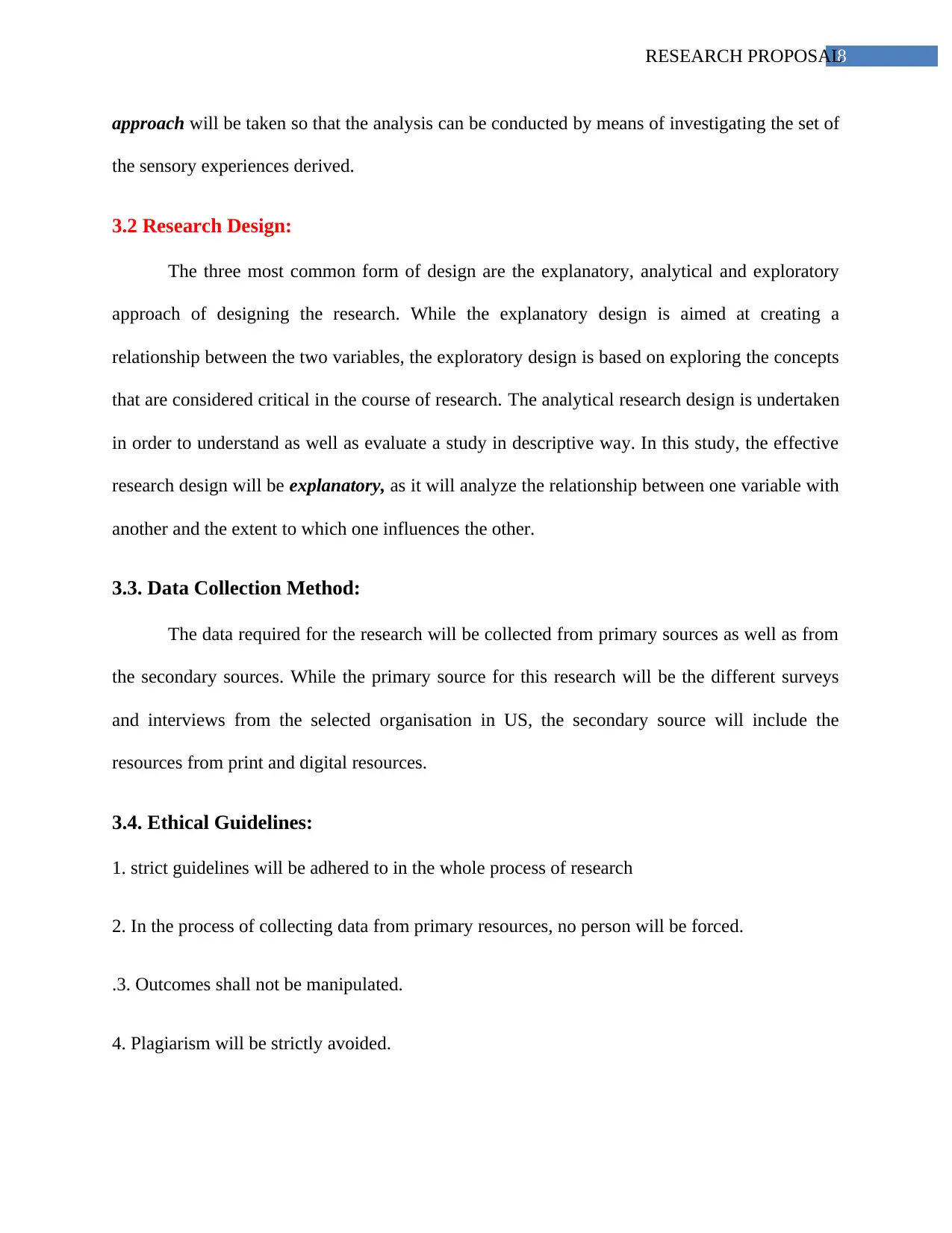
8RESEARCH PROPOSAL
approach will be taken so that the analysis can be conducted by means of investigating the set of
the sensory experiences derived.
3.2 Research Design:
The three most common form of design are the explanatory, analytical and exploratory
approach of designing the research. While the explanatory design is aimed at creating a
relationship between the two variables, the exploratory design is based on exploring the concepts
that are considered critical in the course of research. The analytical research design is undertaken
in order to understand as well as evaluate a study in descriptive way. In this study, the effective
research design will be explanatory, as it will analyze the relationship between one variable with
another and the extent to which one influences the other.
3.3. Data Collection Method:
The data required for the research will be collected from primary sources as well as from
the secondary sources. While the primary source for this research will be the different surveys
and interviews from the selected organisation in US, the secondary source will include the
resources from print and digital resources.
3.4. Ethical Guidelines:
1. strict guidelines will be adhered to in the whole process of research
2. In the process of collecting data from primary resources, no person will be forced.
.3. Outcomes shall not be manipulated.
4. Plagiarism will be strictly avoided.
approach will be taken so that the analysis can be conducted by means of investigating the set of
the sensory experiences derived.
3.2 Research Design:
The three most common form of design are the explanatory, analytical and exploratory
approach of designing the research. While the explanatory design is aimed at creating a
relationship between the two variables, the exploratory design is based on exploring the concepts
that are considered critical in the course of research. The analytical research design is undertaken
in order to understand as well as evaluate a study in descriptive way. In this study, the effective
research design will be explanatory, as it will analyze the relationship between one variable with
another and the extent to which one influences the other.
3.3. Data Collection Method:
The data required for the research will be collected from primary sources as well as from
the secondary sources. While the primary source for this research will be the different surveys
and interviews from the selected organisation in US, the secondary source will include the
resources from print and digital resources.
3.4. Ethical Guidelines:
1. strict guidelines will be adhered to in the whole process of research
2. In the process of collecting data from primary resources, no person will be forced.
.3. Outcomes shall not be manipulated.
4. Plagiarism will be strictly avoided.
⊘ This is a preview!⊘
Do you want full access?
Subscribe today to unlock all pages.

Trusted by 1+ million students worldwide
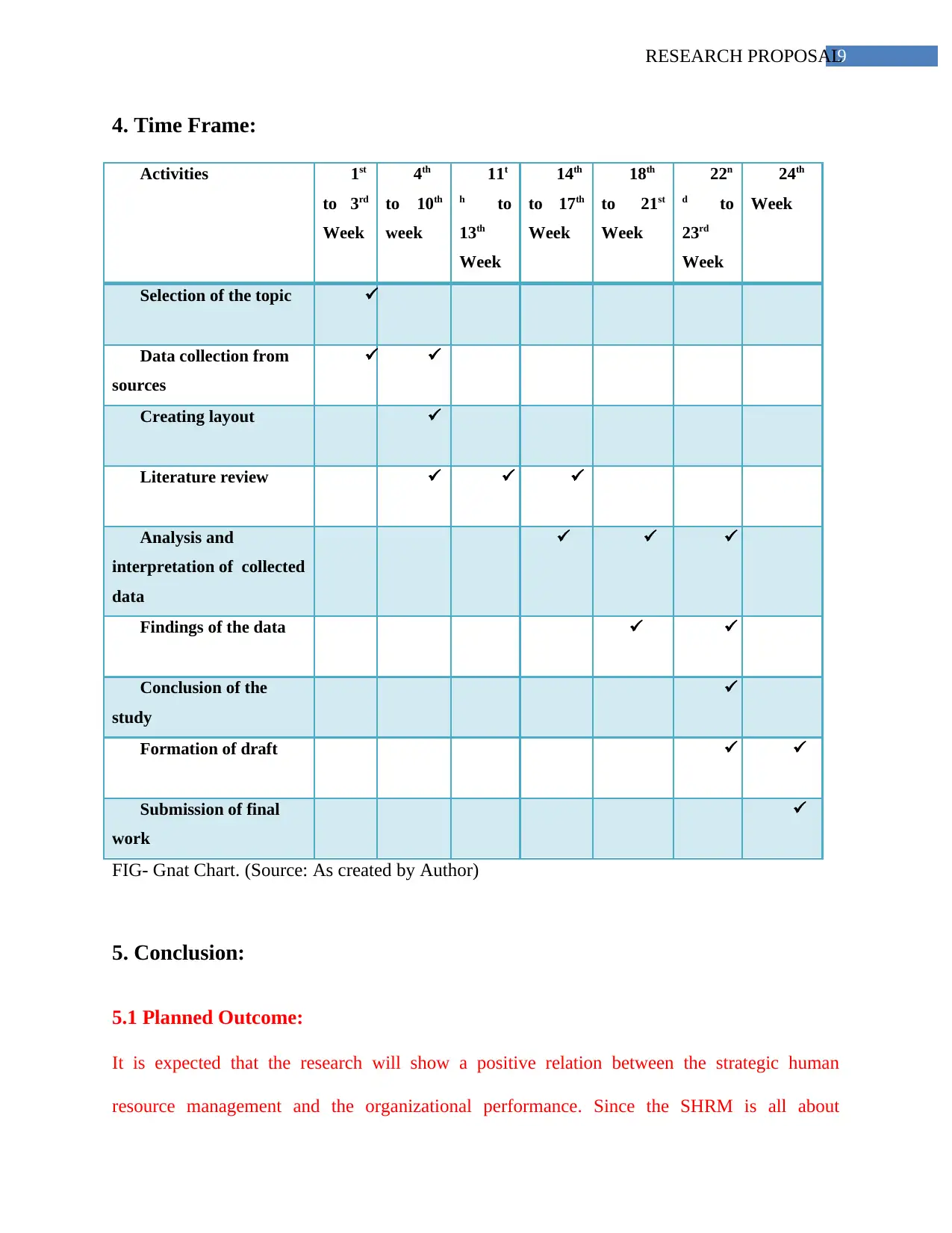
9RESEARCH PROPOSAL
4. Time Frame:
Activities 1st
to 3rd
Week
4th
to 10th
week
11t
h to
13th
Week
14th
to 17th
Week
18th
to 21st
Week
22n
d to
23rd
Week
24th
Week
Selection of the topic
Data collection from
sources
Creating layout
Literature review
Analysis and
interpretation of collected
data
Findings of the data
Conclusion of the
study
Formation of draft
Submission of final
work
FIG- Gnat Chart. (Source: As created by Author)
5. Conclusion:
5.1 Planned Outcome:
It is expected that the research will show a positive relation between the strategic human
resource management and the organizational performance. Since the SHRM is all about
4. Time Frame:
Activities 1st
to 3rd
Week
4th
to 10th
week
11t
h to
13th
Week
14th
to 17th
Week
18th
to 21st
Week
22n
d to
23rd
Week
24th
Week
Selection of the topic
Data collection from
sources
Creating layout
Literature review
Analysis and
interpretation of collected
data
Findings of the data
Conclusion of the
study
Formation of draft
Submission of final
work
FIG- Gnat Chart. (Source: As created by Author)
5. Conclusion:
5.1 Planned Outcome:
It is expected that the research will show a positive relation between the strategic human
resource management and the organizational performance. Since the SHRM is all about
Paraphrase This Document
Need a fresh take? Get an instant paraphrase of this document with our AI Paraphraser

10RESEARCH PROPOSAL
managing the human resource aligning with the organizational strategy, it is assumed that this
will also help in enhancing the performance.
managing the human resource aligning with the organizational strategy, it is assumed that this
will also help in enhancing the performance.
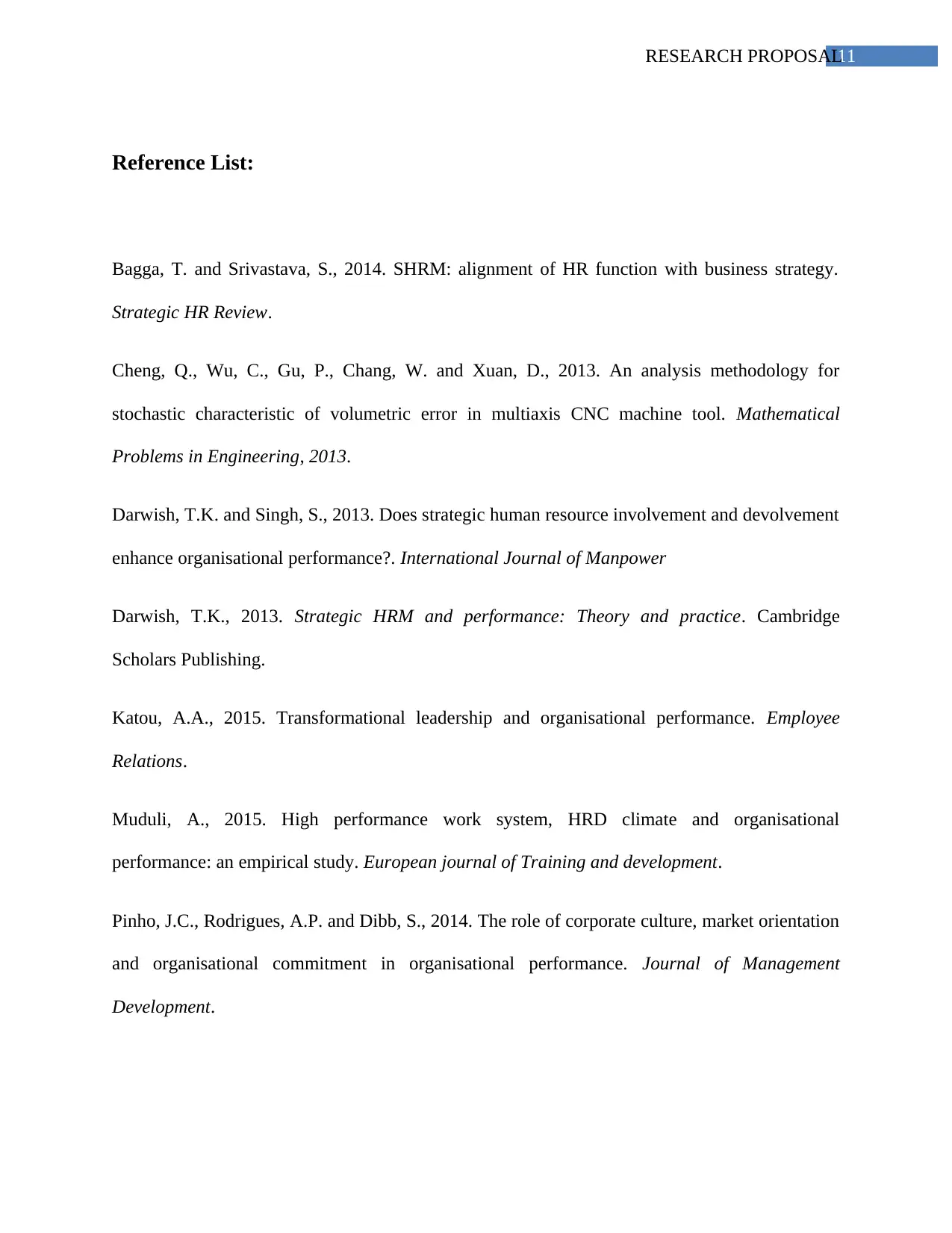
11RESEARCH PROPOSAL
Reference List:
Bagga, T. and Srivastava, S., 2014. SHRM: alignment of HR function with business strategy.
Strategic HR Review.
Cheng, Q., Wu, C., Gu, P., Chang, W. and Xuan, D., 2013. An analysis methodology for
stochastic characteristic of volumetric error in multiaxis CNC machine tool. Mathematical
Problems in Engineering, 2013.
Darwish, T.K. and Singh, S., 2013. Does strategic human resource involvement and devolvement
enhance organisational performance?. International Journal of Manpower
Darwish, T.K., 2013. Strategic HRM and performance: Theory and practice. Cambridge
Scholars Publishing.
Katou, A.A., 2015. Transformational leadership and organisational performance. Employee
Relations.
Muduli, A., 2015. High performance work system, HRD climate and organisational
performance: an empirical study. European journal of Training and development.
Pinho, J.C., Rodrigues, A.P. and Dibb, S., 2014. The role of corporate culture, market orientation
and organisational commitment in organisational performance. Journal of Management
Development.
Reference List:
Bagga, T. and Srivastava, S., 2014. SHRM: alignment of HR function with business strategy.
Strategic HR Review.
Cheng, Q., Wu, C., Gu, P., Chang, W. and Xuan, D., 2013. An analysis methodology for
stochastic characteristic of volumetric error in multiaxis CNC machine tool. Mathematical
Problems in Engineering, 2013.
Darwish, T.K. and Singh, S., 2013. Does strategic human resource involvement and devolvement
enhance organisational performance?. International Journal of Manpower
Darwish, T.K., 2013. Strategic HRM and performance: Theory and practice. Cambridge
Scholars Publishing.
Katou, A.A., 2015. Transformational leadership and organisational performance. Employee
Relations.
Muduli, A., 2015. High performance work system, HRD climate and organisational
performance: an empirical study. European journal of Training and development.
Pinho, J.C., Rodrigues, A.P. and Dibb, S., 2014. The role of corporate culture, market orientation
and organisational commitment in organisational performance. Journal of Management
Development.
⊘ This is a preview!⊘
Do you want full access?
Subscribe today to unlock all pages.

Trusted by 1+ million students worldwide
1 out of 14
Related Documents
Your All-in-One AI-Powered Toolkit for Academic Success.
+13062052269
info@desklib.com
Available 24*7 on WhatsApp / Email
![[object Object]](/_next/static/media/star-bottom.7253800d.svg)
Unlock your academic potential
Copyright © 2020–2025 A2Z Services. All Rights Reserved. Developed and managed by ZUCOL.





